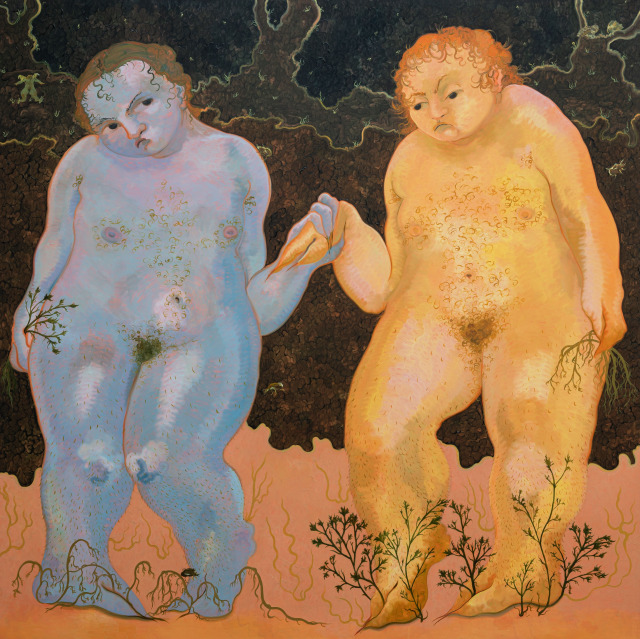In many Anglo-European folk tales, a protagonist must leave home for the unfamiliar outside world, on a quest or a journey, and resolution is only achieved by their return home. After some months travelling abroad, Wilson felt the need to reconsider her sense of belonging to the place she grew up in, England. This body of work has been a means through which the artist has strengthened a personal connection with the natural landscape of her upbringing, and its lore. She considers the way in which a place can entangle and trap you without your consent, and how you can willingly seek out that which will bind you to a place. The creatures in these paintings are nestled and (sometimes literally) entangled within their vegetal surroundings – it is in their nature. Swirling, oozing brushstrokes bind vegetation to flesh and figure to landscape so that each element is interconnected within a wider ecosystem.
Three moons appear in many of the paintings, marking the passing of time in a whole cycle: the sun or moon rises across the sky and then sets. This could mark the passing of a day, a night, or even a whole year or a lunar cycle. Beneath the movements of the cosmos, the creatures stay still, lounging and watching the landscape die down into rotting wood, mulch and bare hedgerows, from which life will regrow and renew itself. The world, imagined by Wilson, is preparing to slow down, to hibernate, retreating into enclosed dark spaces and hollows to rest.
Further into the exhibition, Wilson’s paintings move underground. Underlands, burrows and hidden realms are revealed. A tree’s roots reach deep into the soil: the ‘entrance to the underland’; a grassy mound looms out of the landscape, its curvature suggestive of a sleeping figure; two creatures weave themselves into the undergrowth. Wilson’s animal-like, genderless figures are becoming one with their environmental surroundings, willing their own burial, a return to the earth. The paintings are populated by wildlife species only glimpsed for a fleeting moment by the human world. Nocturnal beasts such as pipistrelle bats, goat moths, sparrow-tailed moths and owls loom out of the gloom amongst brambles and branches. They are the hidden ones, pale in the darkness, never touched by sunlight (and species that are also endangered in the English countryside at this time). Beetles crawl across one canvas, thriving on the vegetal matter that has decomposed but will revive. Wilson skilfully unveils a network of dark hollows and tangling roots, inviting viewers to contemplate unseen aspects of the natural world.
Through her painterly narrative of time passing, of continuous decay and regrowth, Wilson invites us to encounter ourselves within ecological timescales that are grander than we can ever truly grasp hold of. The underland holds what has been hidden or lost and what does not want to be seen. It is our buried past and it is where we will all return.


